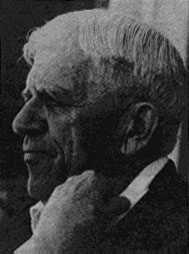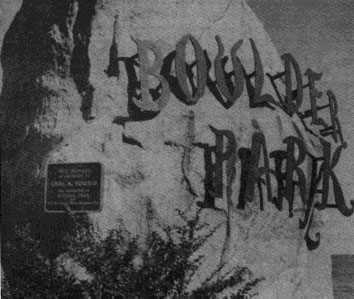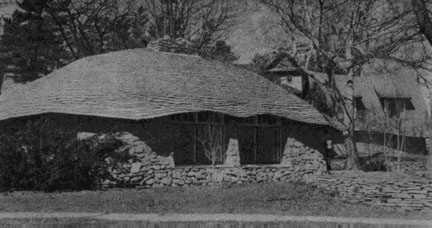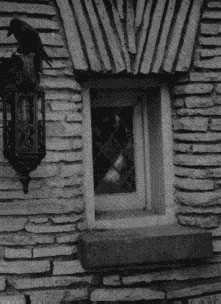Earl Young isn't around any more, but perhaps more than any other single person, he left a visible, lasting legacy and personal imprint on Charlevoix, the city he loved.
The houses and buildings he created continue to fascinate tourists who can't believe their eyes when they see the wave-like rooflines and inimitable stonework that have become his trademarks.
Previous Article • Next Article
Article Index • Charlevoix History Main Page
THE GRAPHIC, Thursday, July 30, 1981
(Continued from Previous Page)
The legacy of Earl Young
By AUDREY COLLINS
"I used to tell people that Earl Young invented the black morel," former Charlevoix Courier editor Bob Clock says. "It just looks like something he would come up with."
People have dubbed his homes the "mushroom houses" because of their irregular shapes, woodsy settings and natural building materials. Others call them "fairy houses" because they possess a certain storybook whimsy.
"Some will tell you Earl Young has waged a lifelong contest with Nature, to prove he can create something equal to the beauty She gave Charlevoix. And some of the same people sometimes admit he may have won," Glen Sheppard penned in a 1967 edition of the Petoskey News-Review.
Young is credited with having designed or built as many as 30 stone houses, all but one in Charlevoix. His first was begun in 1918, about the time the Loeb estate (now Castle Farms Music Theatre) was getting under way.
His best known creations are the Weathervane Inn and the Weathervane Terrace, situated on the Pine River channel in downtown Charlevoix. Once a three-story, metal-covered grist mill, the Weathervane Inn became in Young's imagination and finally in reality, a rambling stone restaurant.
In 1954, he began tearing down the upper stories of the mill, leaving the original foundation and the timbers in the main floor intact. An 18,260 pound stone, almost a perfect map of lower Michigan, became the focal point in the main fireplace.
Young had kept that stone hidden in the woods since 1928, waiting for a project worthy of it. He had workmen leave enough space between rafters so that it could be lowered into place, but it didn't fit so the rafters were removed to accommodate the stone.
"To this day Earl sticks to the original explanation he gave to workmen: 'It grew 11 inches during all those years in the woods'," Sheppard reported in the News-Review.
Boulders were a special love of Young's. One of his favorite houses, set in a grove of towering birch, features a cathedral arch of natural boulders, and frames a window with a breathtaking view of Lake Michigan.
"He tried to fit the house into the area where he was building. His houses look like they belong. They look like they grew there," an admirer says.
Especially true to that description are the houses forming the triangular block facing Park, Clinton and Grant streets, where owners say they are accustomed to watching cars inch past, passengers' necks craned, to take in the unbelievable combination of terraced hillsides and elegant stone cottages.
He saw these things in his mind and he'd make a sketch, according to a long-time associate of Young's. His wife Irene, a pen and watercolor artist, often did the precision drawings from which the houses were eventually built. Then it fell to cooperative carpenters and stonemasons to make it turn out the way he wanted it to look.
His chimneys are capped with cement that falls as naturally over the stone as a whitecap breaks on the beach. Leaded glass windows and doors with beveled glass panes and copper tooled ceilings and natural slate floors add an unexpected elegance to his interiors. Many of these materials he salvaged from demolition projects at the mansions of Chicago lumber barons and stored until he found just the right spot for them.
The Earl Young houses, and particularly the Boulder Park subdivision which bears a placque in his memory, are still showplaces in Charlevoix -- four decades after they were built. His last houses, located on the north shore of Round Lake, indicate that over the years he was increasingly interested in being different, in creating something unique.
Young's faithful companion in his later years was a cream-colored standard poodle named Pamper.
Pamper followed her master on his daily rounds to the post office and other downtown business places.
One day Pamper showed up unexpectedly -- and alone -- at the Courier office across Pine River Channel from Young's basement office in the Weathervane Inn.
The Courier staff let her in and telephoned Young as to her whereabouts.
"It's my fault," Young explained. "I told her at the post office that we had to stop at the Courier office. She remembered, and I forgot."

"THIS BOULDER is dedicated to Earl A. Young, the developer of Boulder Park by the Boulder Park Association." Most of the legacy Young left the city of Charlevoix doesn't bear his name, but his style is unmistakable.
His trips to the Courier office frequently had a motive. Although Young had become very hard of hearing and nearly blind, he turned his interest to writing a book, an anecdotal history of Charlevoix, and valued Bob Clock's opinion of the work."He'd call me up and say, 'You've got to read this right away, I just finished another chapter,' " says Clock, one of the few people privileged to read the manuscript. The volume was typed and ready for printing, but he was always "going to write another chapter." In the winter of 1975, Young, then 86, fell on the ice, broke a hip, and was hospitalized at Little Traverse Hospital. He was later moved to Charlevoix Area Hospital and finally Grandvue Medical Care Facility.

IT COULD BE a sand dune or a mushroom or the elves' section of town, but it isn't. It's part of the architectural legacy Earl Young's imagination and spunk gave to Charlevoix.
Confinement and lack of activity did not agree with the peppery old man, who was known to conspire with visitors to "cut me loose" from the restraints used to keep him safe from further injury. He died six weeks later.It is said that Young was happy with what he created, but never satisfied. He was always ready to start something new, always ready to stretch his imagination.
East Park in Charlevoix exists today in part because of Young's foresight and scrappy leadership. His associates recall stories about Young, going hat in hand to Charlevoix merchants after buildings on the waterfront burned, collecting money to buy the land for the city park.
"He was probably one of the earliest and greatest promoters of Charlevoix as a summer resort community, " says writer Fran Martin of her old friend. "Charlevoix was his love. He did a great deal for the community."
Tourists still stop their cars and get out their cameras to take pictures of Young's one-of-a-kind houses. People who have been raised in the era of cheap mass production will always be captivated by the flowing lines and timeless originality that Earl Young gave to Charlevoix.
